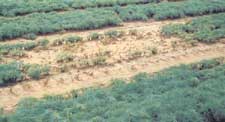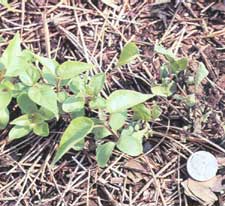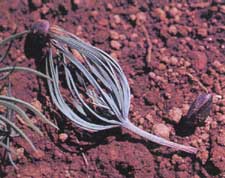Damping-OffWalter D. Kelley - Forest Pathologist, Department of Botany, Plant Pathology and Microbiology, Alabama Agricultural Experiment Station, Auburn University, Auburn, AL, and Cordell C.E., Anderson R.L., Hoffard W.H., Landis T.D., Smith R.S. Jr., Toko H.V., 1989. Forest Nursery Pests. USDA Forest Service, Agriculture Handbook No. 680, 184 pp. Hosts Damping-off, caused most commonly by species of Fusarium, Rhizoctonia, Phytophthora, and Pythium, affects emerging nursery seedlings of most conifer and hardwood species. The junipers are among the few known exceptions. Distribution Nurseries throughout tropical and temperate areas have experienced losses. Because damping-off is caused by a variety of pathogenic fungi with differing environmental requirements, it probably is impossible to establish a bareroot or container nursery beyond the reach of spores of some of these fungi. Damage Damping-off affects seeds and seedlings during germination and emergence. Preemergence damping-off occurs when germinating seeds are affected before their hypocotyls break through the soil surface. Postemergence damping-off occurs shortly after emergence, while tissues are still succulent. Infection usually results in death of the seed or seedling. Diagnosis Losses from preemergence damping-off are subtle and difficult to detect. However, poor emergence in scattered pockets is a good indication that damping-off has occurred (fig. 41-1). Symptoms of postemergence damping-off are different on hardwoods than on conifers. To tell if postemergence damping-off is occurring on hardwood seedlings, look for necrotic areas at or below the groundline. Infected seedlings wilt and die, but they often remain upright (fig. 41-2). The dead seedlings are brittle and break off easily at the groundline.
The pathogen causing a specific incidence of damping-off cannot be determined on the basis of symptoms. Identification usually requires culturing of infected tissues and microscopic examinations. Such identification is usually necessary before specific control recommendations can be made. Biology Most damping-off fungi survive in the soil or in plant debris as dormant spores resistant to environmental extremes. They tend to increase when seedbeds are used continuously without cover crop rotation. Damping-off organisms may be endemic in nursery soil without causing damage but may cause serious problems when environmental conditions are favorable for one or more of the pathogens but unfavorable for early seedling growth. The principal environmental factors influencing disease development are soil pH, moisture, and temperature; effects of these factors vary with the predominant pathogen and the tree species. All damping-off pathogens grow and reproduce best when the pH of soil or growth medium is above the optimum for seedling growth (pH 5.2 to 5.8). Cool, wet soils slow germination and extend the time seeds and germinating seedlings are exposed to pathogens: losses to damping-off increase under such conditions. Excessive soil moisture at moderate temperature favors development of Pythium and Phytophthora spp. Soil texture, organic amendments, and nutrients can also influence disease development. Fine-textured soils with a high clay content retain water and warm slowly in the spring. Organic amendments improve these properties and also provide a substrate for competing fungi. Nitrogen fertilizers applied when seedlings are emerging have sometimes increased seedling losses. Within the same seedbed, the soil environment is highly variable, which may explain why seedling damage is sporadic and usually occurs in pockets. Damage is often associated with impeded surface or subsurface soil drainage. Losses from damping-off can be particularly severe in container nurseries because pathogens can become established in a biologically less complex medium without competition from other microorganisms. Control Cultural - Major problems that can be handled through changes in cultural practices are excessively high soil pH, inadequate soil drainage, and low soil temperatures when seedlings are germinating. Lower the soil pH by adding certain sulfur compounds (granular sulfur or ammonium sulfate) or inorganic acids (sulfuric acid). In bareroot nurseries, improve soil drainage by leveling soil, by installing subsurface drainage tiles, and by adjusting the frequency of irrigation. Irrigation must also be carefully controlled in container nurseries. Minimize exposure of seeds to soil pathogens by delaying sowing until the soil temperature has risen to near optimum for rapid seed germination. Chemical - Soil fumigation is the most effective way to control damping-off. The currently recommended chemicals are mixtures of methyl bromide and chloropicrin. Fumigate when soil temperature, moisture, and physical condition are optimum. Unfortunately, fumigation reduces populations of all soil-inhabiting organisms, some of which are beneficial. In addition, treated areas can become rapidly reinfested by contaminated soil, mulches, irrigation water, or seed. Soil fungicide drenches are effective against some damping-off fungi in container nurseries. To use this approach, the pathogen causing the disease must be correctly identified; many modern fungicides are effective only on certain groups of related fungi. Soil drenches to control damping-off have also been widely applied in bareroot nurseries, but the results are unpredictable. Selected References Boyer James N.; South, David B. 1984. Forest nursery practices in the South Southern Journal of Applied Forestry. 8(2): 67-75. Hartley, C. 1921. Damping-off in forest nurseries. Bull. 934. Washington, DC: U.S. Department of Agriculture, Bureau of Plant Industry. 79 p. Sutherland, J.R. 1984. Pest management in northwest bareroot nurseries. In: Duryea M.L.Landis, T.D., eds . Forest nursery manual: production of bareroot seedlings. The Hague; Boston; Lancaster: Martinus Nijhoff/ Dr. W. Junk Publishers: 2(13-210). Tinus. R. W.; McDonaId. S.E. 1979. Greenhouse pest management. In: How to grow tree seedlings in containers in green- houses. Gen. Tech. Rep. RM- 60. Fort Collins, CO: U.S. Department of Agriculture, forest Service, Rocky Mountain Forest and Range Experiment Station: 159-165. |
Forest Pests: Insects, Diseases & Other Damage Agents |

|
|




